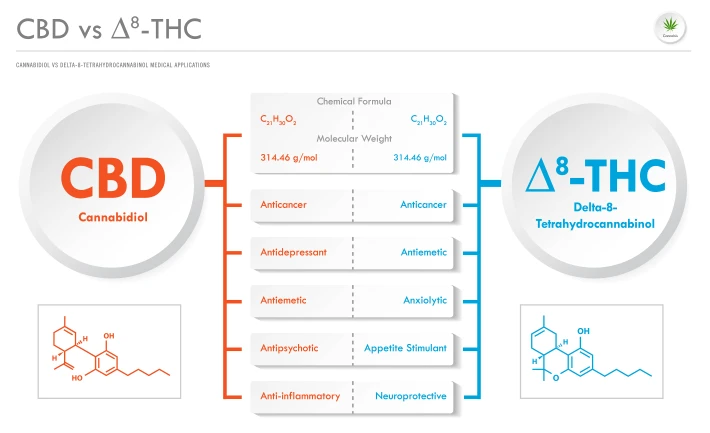Authored by Terrence Shenfield MS, RRT-ACCS, RPFT, NPS, AE-C
Cannabis has taken the health and wellness world by storm, with CBD (cannabidiol) often stealing the spotlight. But did you know that cannabis contains over 100 other cannabinoids, each with unique properties and potential health benefits? Welcome to the world of cannabinoids beyond CBD, where these lesser-known compounds are beginning to make waves for their therapeutic impact.
This guide dives into the diverse world of non-CBD cannabinoids, their benefits, and how you can incorporate them into your wellness routine.
Understanding Cannabinoids Beyond CBD
Cannabinoids are naturally occurring compounds found in the cannabis plant. While CBD and THC (tetrahydrocannabinol) are the most well-known, dozens of other cannabis cannabinoids explained hold immense potential for health and wellness.
Non-CBD cannabinoids such as CBG (cannabigerol), CBN (cannabinol), and THCV (tetrahydrocannabivarin) interact with the body's endocannabinoid system (ECS) differently. This system regulates functions like sleep, appetite, mood, and pain. These cannabinoids offer unique benefits, expanding possibilities for therapeutic applications.
The Benefits of Non-CBD Cannabinoids
Cannabigerol (CBG): The "Mother of Cannabinoids"
CBG is often referred to as the precursor cannabinoid since it converts into other cannabinoids, including THC and CBD, during plant growth. While less abundant in mature cannabis plants, CBG has been studied for its potential to:
- Reduce inflammation in conditions like Crohn’s disease.
- Support eye health by lowering intraocular pressure.
- Promote neuroprotection and brain health.
Cannabinol (CBN): The Sleep Aid
CBN is created as THC ages. Unlike THC, it is non-psychoactive but has demonstrated sedative properties. Many brands now market CBN products for sleep support. Potential benefits include:
- Improved sleep quality.
- Pain relief due to its analgesic properties.
Tetrahydrocannabivarin (THCV): The Appetite Suppressant
THCV stands apart from THC due to its appetite-suppressing effects. It shows promise in areas such as:
- Supporting weight management.
- Regulating blood sugar levels, potentially benefiting those with diabetes.
For a detailed breakdown of these and other non-CBD cannabinoids, visit www.atecam.com.
How Non-CBD Cannabinoids Compare to CBD
While CBD is celebrated for its wide-ranging therapeutic benefits, including anxiety relief and pain management, other cannabinoids offer targeted benefits often overlooked. The entourage effect, a phenomenon where cannabinoids work better together than alone, demonstrates the important role cannabinoids beyond CBD play in optimizing cannabis's full potential.
Incorporating Non-CBD Cannabinoids into Your Wellness Routine
- Choose Full-Spectrum Products
Full-spectrum cannabis products include a variety of cannabinoids, ensuring you benefit from the entourage effect. Look for products that specify their cannabinoid profiles on the label.
- Understand Your Needs
Determine whether you're seeking relief from a specific issue, such as sleep difficulties or inflammation. Cannabinoids like CBN or CBG may be more beneficial for targeted concerns.
- Start with Smaller Doses
Non-CBD cannabinoids can be potent. Start with a small dose and monitor your body’s response before increasing consumption.
To explore a range of full-spectrum products crafted for well-being, visit the ATECAM store.
The Importance of Research
Understanding non-CBD cannabinoids continues to be an area of active study. Researchers are exploring the potential of cannabinoids in managing chronic conditions, promoting mental health, and improving overall well-being.
The United Nations World Health Organization notes that cannabinoids remain a promising field in therapeutic applications. Their versatility goes far beyond what was once thought possible.
Why ATECAM is Your Trusted Resource
At ATECAM, we’re committed to bringing you evidence-based insights on wellness, including the science of cannabinoids. Every product we carry is rigorously tested for quality, safety, and efficacy. Our resources, curated by healthcare professionals, empower you to make informed decisions and enhance your quality of life.
Explore our library of articles, including insights on cannabis and CBD at www.atecam.com.
Final Thoughts
While CBD has become the face of cannabis, the future lies in unlocking the potential of non-CBD cannabinoids. Compounds such as CBG, CBN, and THCV are gaining recognition for their targeted benefits, paving the way for a more holistic approach to cannabis wellness.
Whether you're new to cannabinoids or seeking to expand your wellness toolkit, exploring cannabinoids beyond CBD can open doors to improved health and understanding. Invest in products backed by research and consider consultants or professionals to guide you in choosing what’s best for your needs.
For tailored guidance and to shop premium-grade cannabis products, head to ATECAM here.
References
- Russo, E. B. (2011). Taming THC: potential cannabis synergy and phytocannabinoid-terpenoid entourage effects. British Journal of Pharmacology, 163(7), 1344–1364.
- World Health Organization. (2019). "Cannabis and cannabinoids." WHO.int
- Pamplona, F. A. (2018). Cannabidiol interference in endocannabinoid signaling. Frontiers in Pharmacology, 9, 1369.
- ATECAM Educational Resources. (2023). "Exploring Cannabinoids Beyond CBD in Cannabis." ATECAM.com
- ElSohly, M. A., & Slade, D. (2005). Chemical constituents of marijuana. Life Sciences Archives.



